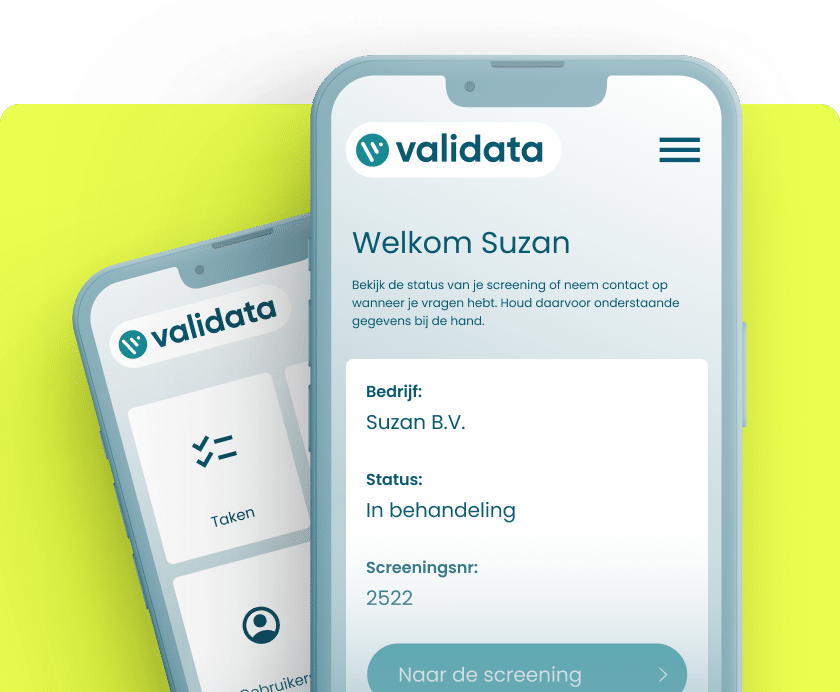The procedure for successful pre-employment screening
Below we explain the best way to go through the steps of the screening procedure.
1. Determine if you need a screening policy
The first step to a successful pre-employment screening is to establish a good screening policy to successfully implement the screening process. By means of a clear screening policy, you ensure that your processes are always fair, consistent and comply with legal requirements.
It also enables you to set certain requirements for things, such as how your organisation hires and retains employees, and what role pre-employment screening plays in this.
2. Decide where you're going to securely store personal data
It is very important to store personal and sensitive information securely. The systems and/or processes used for this must comply with the GDPR (General Data Protection Regulation). This means that clear agreements must be made with regard to security and who has access to the data. By using a good secure screening software, you ensure compliance with the requirements and the data is managed securely.
3. Determine the screening requirements
You start by determining what specific requirements you need for the candidates. This depends on the position, but also on the sector. For example, within the financial sector, or a financial function within another sector, an integrity check is often carried out, a VOG (Certificate of Good Conduct) is applied for and/or a Wft (Financial Supervision Act) diploma is checked. By establishing clear screening requirements, you ensure that you only collect and review the most relevant information for an informed decision.
4. Determine through which authorities you will check the candidate’s data
The data provided by your candidates often need to be checked by external authorities. This varies from, for example, (school) diploma’s to VOG’s. The authorities where you will check the data must also be verified for the specific requirements you have compiled for certain positions. In addition, it is important that you work with official authorities to ensure that the information provided is checked correctly.
5. Request information and permission from the candidate
Before you start screening, it is important to first request the information and permission from the candidate. You need to make sure the candidate knows what data is being requested, why, and how this data is being processed. Clear communication with the candidate will help you avoid misunderstandings and ensure that you comply with GDPR regulations.
6. Check the received information
Once all the requested information has been received, it’s time to start screening. This means that it is checked whether the information provided is consistent with the information provided by external sources or authorities. By noting any incorrect data, you ensure that you prevent problems later on.
7. Evaluate the received information
The final step in the process is to check the screened information. By evaluating the data, you can make a decision about whether the candidate is suitable for the position. It is important to evaluate not only the results, but also the context of certain findings. This provides clarity and minimises risks. This way, you will use a careful process to ensure that you hire the most suitable candidates.

Shorten the employment screening procedure
Selecting the right candidates or mitigating certain risks during a pre-employment screening can be a time-consuming process. Especially if you have to go through all the steps manually. Fortunately, there are solutions for this, such as a screening software. By automating steps in the process, you speed up the process of a screening. In addition, you can store data securely, perform certain checks faster and communicate better with candidates if you use screening software.
Request a demo
- GDPR proof: Compliance with the General Data Protection Regulation is our main focus, ensuring the protection of privacy and personal data of our clients
- Efficient: Validata streamlines the screening process with easy-to-use technologies that automate the process.
- Save costs: Hiring a mis-hire comes with a lot of costs and other risks. By knowing who you’re hiring, you minimise this risk. In the end, you’ll spend less money.
Neem contact op
"*" indicates required fields
Neem contact op
"*" indicates required fields
Neem contact op
"*" indicates required fields
Neem contact op
Neem contact op
Download de whitepaper
Download de whitepaper
Download de whitepaper
Download de whitepaper
Download de whitepaper
Download de whitepaper
Download de whitepaper
Download de whitepaper
Meld je hier aan
Neem contact op
"*" indicates required fields
"*" indicates required fields
"*" indicates required fields
<!– Calendly link widget begin –>
<link href=”https://assets.calendly.com/assets/external/widget.css” rel=”stylesheet”>
<script src=”https://assets.calendly.com/assets/external/widget.js” type=”text/javascript” async></script>
<a href=”” onclick=”Calendly.initPopupWidget({url: ‘https://calendly.com/basteeuwen/small-demo-validata’});return false;”>Schedule time with me</a>
<!– Calendly link widget end –>
"*" indicates required fields
 Switch region
Switch region 





